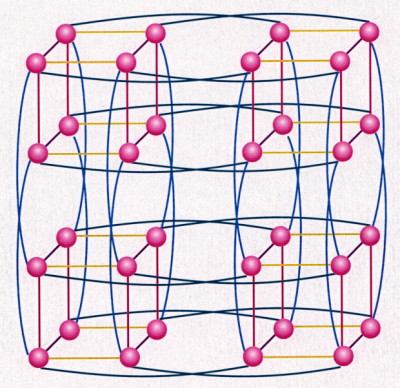|
Decoding the Silent Lyrics of Rain Forests
The destruction of the rain forests will threaten the survival of the human race. The rain forests is an amazing living botanical computer that has survived for 500 million years. Our goal is to understand how it grows, moves, repairs and reproduces itself and then apply lessons learned from it to designing computers and the Internet. Aristotle wrote that plants have soul and his belief was shared by scholars of the Middle Ages. Some researchers believe that we have not fully understood the mysteries of plants and the rain forests and even suggest that there are emotional, spiritual and physical relations between plants and humans. None other than Alfred Lord Tennyson penned the glorious lines: Flower in the crannied wall,Some controversial experiments have shown that plants can respond to music and even talk with humans. I believe that plants are botanical computers. Just as computers with artificial neural networks are modeled after the human brain, I believe that phytocomputers with branching patterns governed by the Fibonacci sequence can be modeled after plants.
Building a Phytocomputer from Emeagwali's HypertreeThe processing nodes of first-generation parallel computers were interconnected in a hypercube pattern. In the 1990s, computer scientists believed that hypercubes were the most efficient networks for designing parallel computers. My study of the branching structure of trees shows that the hypercube is not the best choice. It was adopted, I believe, because it is symmetrical and regular and, therefore, pleasing to the humans.My research has shown that the branching structure used by plants are more efficient than that used by computer manufacturers. During the process of evolution, plants have achieved the optimal branching structure that will enable them to survive. This branching structure is mathematically described by the well known Fibonacci sequence of numbers: 0, 1, 1, 2, 3, 5, 8, 13, 21, . . . . I have designed a new network that satisfies the Fibonacci sequence. This new information pathway, called Emeagwali's hypertree, is three-dimensional in shape and similar to trees.

The information pathways of a hypercube computer. The 32 dots represent 32 processing nodes. The lines represent the communication links used to send (or receive) information from one processing node to another.
If trees could whisper, what secrets would they tell?What do airplanes, cars and computers have in common? Their designs were inspired by animals (i.e. birds, horses and humans, respectively). For the first time, I will design a computer that is inspired by plants instead of animals.In the past, plants and animals were on the same branch of the evolutionary tree. Therefore, the design of computers can also be inspired by plants. There are dozens of similarities between a tree and a phytocomputer which are analogous to those between birds and airplanes. I will give a few examples. The annual rings of a tree correspond to the communication channels of a phytocomputer. The (sap and water) transporting capacity of the tree increases when the tree adds an annual ring. Similarly, the phytocomputer's information transporting capacity increases when a communication channel is added at each level.

The annual rings of a tree correspond to the communication channels of a phytocomputer.
According to Leonardo da Vinci: "All the branches of a tree at every stage of its height when put together are equal in thickness to the trunk." Similarly, all the branches of a phytocomputer at every level has a constant information transmission capacity. A broken branch of a tree is analogous to a malfunctioning processing node of a phytocomputer. The transport capacity of a tree decreases gradually when a branch is broken. Similarly, the information transmission rate of a phytocomputer decreases gradually when a processing node malfunctions. In fact, the preceding analogy can also be extended to the failure of regional networks within the Internet. In this case, the failure of a sub-network of the Internet will be analogous to the destruction of a portion of a rain forest.

The information pathways of a phytocomputer. The 32 dots represent 32 routers. The 16 squares represent 16 processing nodes. The lines represent the communication links used to send (or receive) information from one router (or processor) to another.
If trees could talk, what would they say?If water is the blood of the Earth, trees are its lungs. Many religions revere trees. Buddha gained enlightenment while sitting beneath a tree. IBM research chemist Marcel Vogel conducted research that convinced him that trees can read our minds. Vogel wrote:It is fact: man can and does communicate with plant life. Plants are living objects, sensitive, rooted in space. They may be blind, deaf, and dumb in the human sense, but there is no doubt in my mind that they are extremely sensitive instruments for measuring man's emotions.Where did the human brain evolve from? The "Tree of Life" shows that animals and plants have a common primordial ancestor. Therefore, it should not come as a surprise that plants may possess intelligence. The attributes of intelligence possessed by plants include (1) color vision or ability to respond to different wavelengths of light, (2) response to the direction of light, and (3) the ability to intrinsically compute the length of the day. The primitive intelligence of plants has made it difficult for humans to communicate with them. Although plant intelligence does not bear any resemblance to humanoid intelligence, it can be a suitable metaphor and inspiration for designing computers and the Internet. The brain of a tree of a tree is not as complex as that of a human being. Although trees lack the complex emotions and sensory inputs of humans, I believe that it is similar to a neural network with its decision-making ability physically distributed throughout its body. The latter will be more easily understood by imagining the trunk, branches and roots to be represented by weighted edges that are proportional to the cross-sectional area and/or transport capability. The leaves can also be represented by weighted vertices proportional to the sunlight gathering ability. From the latter, the tree could be analyzed as a neural network with learning ability that allows it to grow in a direction that maximizes its sunlight gathering ability. Its extremely primitive decision making ability is accomplished by globally and continuously readjusting the transport capacity of the trunks and the exposed surface area of its leaves and, in effect, always modifying its growth pattern in response to environmental stresses. From the latter perspective, trees are naturally intelligent, biological, and distributed massively parallel computers used for gathering sunlight needed for photosynthesis and for extracting water and minerals from the soil needed for food. Two millennia later, we might re-discover that Aristotle was right when he wrote that plants have soul. We have gone a full circle and back to T. S. Eliot who wrote: "We shall not cease from exploration, and the end of all our exploring will be to arrive where we started and know the place for the first time." If trees could sing, what would the tune be?We tried to communicate with dolphins. We have spent hundreds of millions of dollars searching for extraterrestial intelligence. At the same time, we are unaware of plant intelligence on planet Earth. The rain forests is home to many species of life forms that are alien to humans. Some of these species are now extinct and will remain undiscovered forever. As science fiction writer Ursula K. LeGuin warned:And with them [the animal and plant linguists], or after them, may there not come that even bolder adventurer --- the first geolinguist, who, ignoring the delicate, transient lyrics of the lichen, will read beneath it the still less communicative, still more passive, wholly atemporal, cold, volcanic poetry of the rocks: each one a word spoken, how long ago, by the earth itself, in the immense solitude, the immenser community of space. Phytocomputing in the 8th ContinentThe rain forests are the untapped technological gold mines for the 21st century. Who knows the scientific breakthroughs that are buried in the forests? I plan expeditions to set up a research station in the African rain forest. I hope to explore the rain forests for plant species that will provide better clues on how to design a phytocomputer. In the past, computers were used to study the rain forests. Now, the rain forests will be used to study computers. This paradigm shift will enable us to understand the technology evolved by nature in the rain forests.
My native country of Nigeria has lost 90 percent of its rain forest.
Nigerians destroyed their rain forest because they did not
understand it. Unless we understand the rain forests, we cannot care for them.
And if we do
not care for the rain forests, they will not be preserved for the
future. Hopefully, the discoveries from my expedition will open a new era in rain forest
research and encourage mankind to preserve our 8th continent.
Please visit http://emeagwali.com
for more technology essays by Philip Emeagwali | ||

